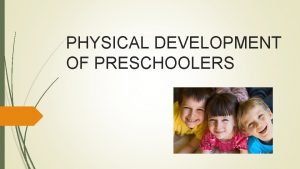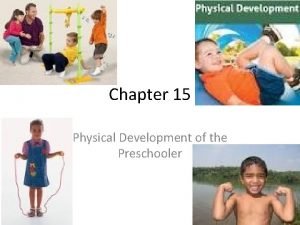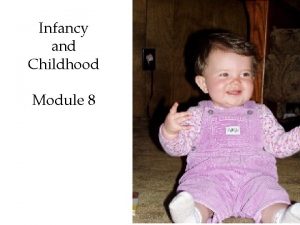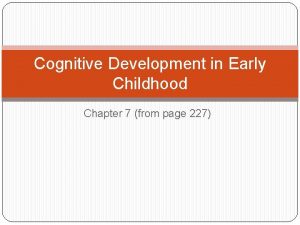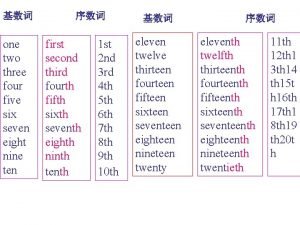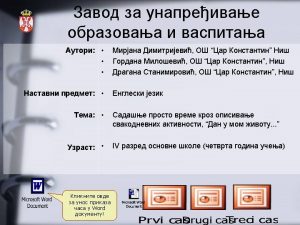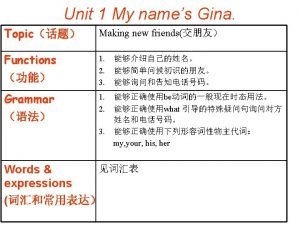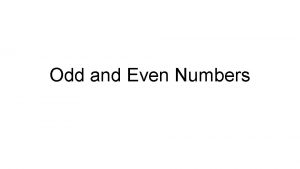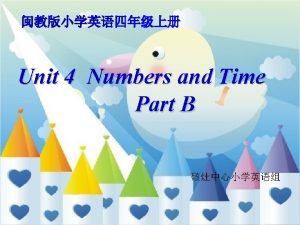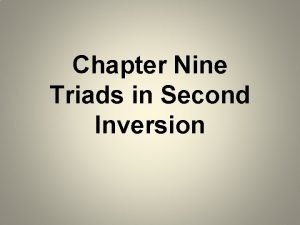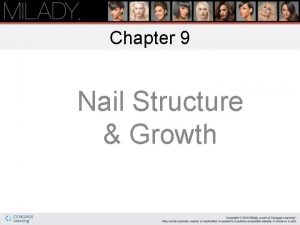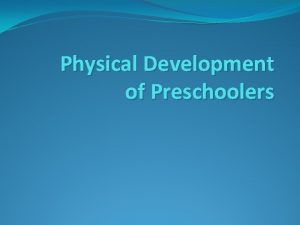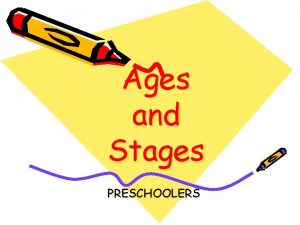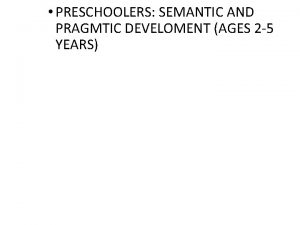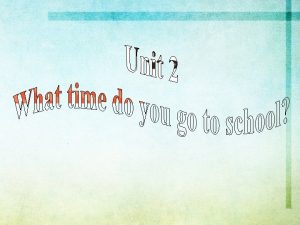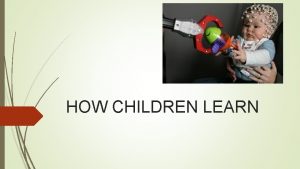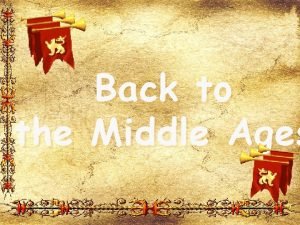Preschoolers Preschoolers Children ages four to six are
























- Slides: 24

Preschoolers

Preschoolers • Children ages four to six are often called preschoolers. • Children of this age are known for their activity. • This is a time of practicing and refining physical skills. • “Practice makes perfect”

Growth and Development • The average yearly increase in height is 2 ½-3 inches. • Most children gain 4 -5 pounds per year during this period. • Boys tend to be slightly taller and heavier than girls at this age. • They are becoming straighter and slimmer.

Preschooler’s Physical Development About the age of 6 children begin to lose their primary teeth. Larger permanent teeth begin to appear. Their six-year molars are the first of their secondary teeth to appear. David goes to the Dentist

You Tube Clip OMW. LOLOLOL David after Dentist http: //www. youtube. com/watch? v=txqiw rb. YGrs

Large and Small Motor Skills • Most large motor skills become well-developed and there is significant improvement in their small motor skills. • Recess is important! Why? • The skilled use of their hands has improved. – However, most children cannot tie their shoes until about age 5. • Most children by age 5 consistently use either their right or left hand. Preference for the right or left hand begins before a child’s second birthday. – It is not a good idea to try and change a child’s hand preference. – Ambidextrous means what?

You Tube Clip Sponge Bob tying shoes http: //www. youtube. com/watch? v=Zv. MU lywp. Yr 8&feature=fvst

Motor Skills • Four Years: skips and hops, laces shoes, dresses/undresses, cuts on lines, can jump forward and up and down, throws overhand • Five Years: ties shoes, draws people and letters, balances on tiptoe, buttons, snaps, zips clothes, picks up small items • Six Years: throws and catches ball, builds block towers to shoulder height, cuts, pastes, molds, colors skillfully, writes entire words.

Self Care • Children need help in maintaining cleanliness habits. Poor habits that are acquired can continue into adulthood.

Social and Emotional Development

Four Year Olds • • • More interested in friends than in adults They play best in groups of 3 -4 They are often bossy and inconsiderate Fighting is common They have a strong sense of family and home Often fight with brothers and sisters

Four Year Olds • Most are not as pleasant to live with as they were at age 3. • They are more selfish, impatient, defiant, and boastful. • They can be loving and affectionate. • They need and seek parental approval. • They are increasingly independent.

Four Year Olds • Use their language ability with enthusiasm. • They boast, tell tales, and tattle on others. • They have difficulty separating fact from fantasy. • Their exaggerations are not deliberate lies. • They do not like people to laugh at their mistakes and they do not want to be a baby anymore. • BLOOD!: )

Five Year Olds • More outgoing and talkative • They play best in groups of 5 -6 • Their play is more complicated and they have more respect for the belongings of others. • They are more concerned about what their friends say and do. • They do not like to be different from their friends. • They play much better with younger brothers and sisters. • Jessica’s Daily Affirmation

You Tube Clip Jessica’s Daily Affirmation http: //www. youtube. com/watch? v=q. R 3 r. K 0 k. ZFkg

Five Year Olds • Five year olds enter a quiet period. • They are practical, sympathetic, and serious. • They conform to rules more easily. • Adult criticism is hard for them to take. • http: //www. youtube. com/watch? v=T Mrr 8 otht. R 0&feature=related

Six Year Olds • Six year olds want everything and want to do things in their own way. • Their best friends are usually of the same sex. • They tend to form groups that exclude other children. • They like group play and organized teams. • They are very self-centered and argue with their parents. • Six year olds are stubborn and quarrelsome. • They resent directions and know everything. • They are the center of their own universe and are often worst with their parents. • http: //www. youtube. com/watch? v=0 rb. MHLDY 1 p. A

Anger • A major emotion that changes with age is anger. • For example, at age four, a child still likes to fight with others. • At age five, children tend to hurt others feelings rather than hurt them physically. • At age six, children tease, insult, nag, and make fun of others.

Emotions • Because children ages 4 -6 have welldeveloped imaginations they often have fears based upon imaginary dangers. • Sensitive and insecure children are more prone to fear. • Fear of the dark is common. • Jealousy of brothers and sisters is common at this age. – It often takes the form of tattling, criticizing, or lying.

Cognitive Development

Preoperational Thinking • Piaget described the age from 2 -7 as the preoperational thinking stage. • Some signs of preoperational thinking: – Children learn that objects and words can be symbols. – Children learn through fantasy, creative, and dramatic play. – Children continue to view the world in terms of themselves. They are self-centered. – Children find it difficult to focus on more than one thing at a time.

Intelligence Test • First intelligence test was developed by the French psychologist, Alfred Binet in 1905. Later, Stanford University adapted the test. It is now called the Stanford Binet test. • The score or intelligence quotient IQ, is simply a number that tells whether a child shows intelligence that is average, above or below average for his/her age. • The average IQ is 90 – 110 • http: //www. youtube. com/watch? feature=fvwp& v=lt. XUyk. Ec. Yx. M&NR=1

Learning • 4, 5, and 6 year olds learn from a variety of experiences. • Whether or not children enjoy reading, art and music depends largely upon attitudes of their parents. • By school age, language ability is one of the most dependable indications of intellectual development.

Techniques for working with children: • Look for opportunities to talk with children about what they are doing. • Ask questions that require more than a yes or no answer. • Ask a child’s opinion or views about something. • Children need to be included in clean-up tasks. • Talk to children when traveling or going places about what they see and visit. • Help children to learn and understand their world through experiments. • http: //www. youtube. com/watch? v=A 2 e. Cy. S 8 v 7 tc
 Antigentest åre
Antigentest åre Dark ages def
Dark ages def Renaissance vs medieval art
Renaissance vs medieval art Physical growth of preschoolers
Physical growth of preschoolers Module 15 preschoolers physical development
Module 15 preschoolers physical development Preschoolers often have trouble buttoning shirts
Preschoolers often have trouble buttoning shirts When preschoolers are given tasks that are simplified
When preschoolers are given tasks that are simplified A polygon with six congruent sides and six congruent angles
A polygon with six congruent sides and six congruent angles One two three four five six seven
One two three four five six seven One two three four five six numbers
One two three four five six numbers One two three four five six
One two three four five six It's a half past six
It's a half past six One two three four five six
One two three four five six Printable raffle tickets 1-100
Printable raffle tickets 1-100 One two three four five six to hundred
One two three four five six to hundred Passing six four
Passing six four Two four six
Two four six Shape with four straight sides
Shape with four straight sides Four eyes skin assessment tool
Four eyes skin assessment tool Nail structure and growth
Nail structure and growth Why were the tang and song dynasties golden ages
Why were the tang and song dynasties golden ages Different ages of english literature
Different ages of english literature Middle ages 1066 to 1485
Middle ages 1066 to 1485 Middle ages floral design
Middle ages floral design The catholic church hierarchy pyramid
The catholic church hierarchy pyramid



